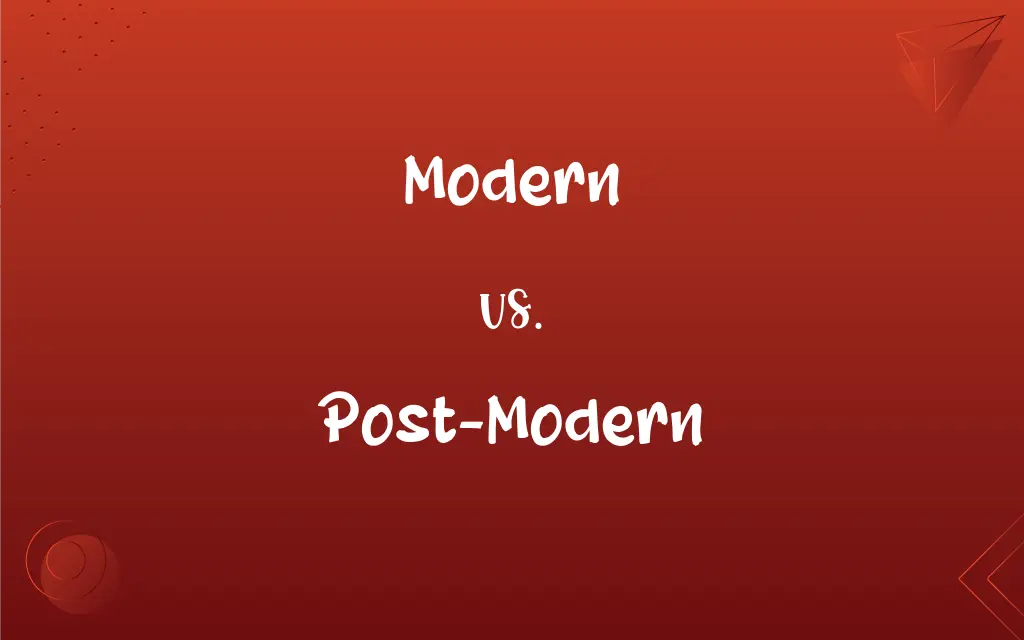Modern vs. Post-Modern: What's the Difference?
Edited by Aimie Carlson || By Janet White || Published on January 24, 2024
Modernism focuses on rationality and absolute truths, characterized by a structured, objective approach, while Post-modernism rejects these notions, embracing subjectivity and questioning established narratives.

Key Differences
Modernism is an artistic and cultural movement that emphasizes progress and rationality, often characterized by a clear, structured approach in arts and architecture. In contrast, Post-modernism is a subsequent movement that rejects the notion of absolute truths, focusing instead on the subjective and the relative.
In literature and art, modernism often manifests as a quest for truth and an exploration of the human condition in a rapidly changing world. Post-modernism, on the other hand, deconstructs these narratives, presenting multiple perspectives and embracing paradoxes.
Architecturally, modern designs are noted for their minimalism, functional structures, and use of new materials like steel and glass. Post-modern architecture, however, often incorporates eclectic styles, historical references, and a playful, ironic take on traditional designs.
In philosophy, modernism is associated with the Enlightenment and the pursuit of objective knowledge through science and reason. Post-modernism challenges this, suggesting that knowledge and truth are culturally and socially constructed, and thus, subjective.
The modern era, generally defined as the late 19th and early 20th centuries, reflects a confidence in progress and technology. The post-modern era, emerging in the mid-20th century, questions this confidence, emphasizing pluralism, skepticism, and the idea that reality is constructed.
ADVERTISEMENT
Comparison Chart
Belief in Truth
Emphasizes absolute truths
Rejects absolute truths
Approach to Art
Structured, objective
Eclectic, subjective
Architectural Style
Minimalist, functional
Eclectic, playful
Philosophical Basis
Enlightenment, rationality
Skepticism, social constructs
View of Progress
Confidence in progress
Questions notions of progress
ADVERTISEMENT
Modern and Post-Modern Definitions
Modern
Relating to the present or recent times.
The museum features modern art from the 20th century.
Post-Modern
After or in reaction to the modern, especially in art, architecture, and literature.
The building's design is a perfect example of post-modern architecture.
Modern
In terms of art, reflecting new and innovative styles.
His paintings are a blend of modern and traditional styles.
Post-Modern
Characterized by a departure from modernist principles.
Her artwork is post-modern in its rejection of traditional forms.
Modern
Pertaining to the modern era or modernism.
Modern philosophy has evolved significantly over the centuries.
Post-Modern
Embracing irony, playfulness, and eclecticism in expression.
The novel is a post-modern pastiche of different genres.
Modern
Characterized by or using the most up-to-date techniques, ideas, or equipment.
They live in a house with all the modern conveniences.
Post-Modern
Relating to a movement that questions the certainties of modernism.
Post-modern philosophy often challenges established norms and truths.
Modern
Denoting the period of history from the late 19th century to the present.
Modern history witnessed unprecedented technological advancements.
Post-Modern
Pertaining to the late 20th century and early 21st century cultural, artistic, and literary trends.
Post-modern literature frequently experiments with narrative structure and voice.
Modern
Of or relating to recent times or the present
Modern history.
Post-Modern
Alternative form of postmodern
Modern
Characteristic or expressive of recent times or the present; contemporary or up-to-date
A modern lifestyle.
A modern way of thinking.
FAQs
When did post-modernism emerge?
Post-modernism emerged in the mid-20th century.
Are modern art and post-modern art similar?
No, they differ in style, with modern art being more structured and post-modern art being more eclectic.
Does post-modern architecture include historical references?
Yes, post-modern architecture often incorporates historical elements.
What is the time frame of modernism?
Modernism generally refers to late 19th and early 20th centuries.
Do post-modern works use irony and parody?
Yes, post-modern works frequently employ irony and parody.
Are modernist works typically serious in tone?
Yes, modernist works often have a serious and structured tone.
Can modern architecture be functional and aesthetic?
Yes, modern architecture emphasizes both function and aesthetics.
Does post-modernism embrace subjectivity?
Yes, post-modernism focuses on subjectivity and relativism.
Does post-modernism question established narratives?
Yes, post-modernism challenges and questions established narratives.
Can modern literature have a linear narrative?
Yes, modern literature often features a linear narrative.
Can a work be both modern and post-modern?
While rare, some works may exhibit characteristics of both movements.
Is modernism based on rational thought?
Yes, modernism is grounded in rationality and scientific thinking.
Can modern design be minimalist?
Yes, modern design often features minimalism.
Does post-modern literature experiment with form?
Yes, post-modern literature is known for experimenting with form.
Are modern technologies typically advanced?
Yes, modern technologies are usually advanced and contemporary.
Does post-modernism include a mix of different genres?
Yes, post-modernism often blends various genres and styles.
Is modernism optimistic about progress?
Yes, modernism generally exhibits optimism about progress.
Is post-modern art diverse in its styles?
Yes, post-modern art is known for its stylistic diversity.
Do modernist philosophies emphasize objective knowledge?
Yes, modernist philosophies focus on objective knowledge.
Does post-modernism have a definitive set of characteristics?
No, post-modernism is diverse and resists a single defining set of traits.
About Author
Written by
Janet WhiteJanet White has been an esteemed writer and blogger for Difference Wiki. Holding a Master's degree in Science and Medical Journalism from the prestigious Boston University, she has consistently demonstrated her expertise and passion for her field. When she's not immersed in her work, Janet relishes her time exercising, delving into a good book, and cherishing moments with friends and family.
Edited by
Aimie CarlsonAimie Carlson, holding a master's degree in English literature, is a fervent English language enthusiast. She lends her writing talents to Difference Wiki, a prominent website that specializes in comparisons, offering readers insightful analyses that both captivate and inform.






































































